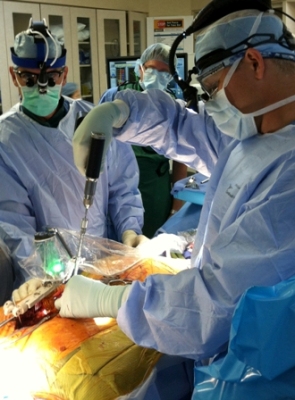Jun 21 2013
Dr. Christopher R. Good, Spinal Specialist at the Virginia Spine Institute, performed the first robot-guided sacroiliac joint (SI) fusion procedure in North America at Reston Hospital Center. This technological advancement allows for increased surgical accuracy and enhanced patient safety while performing this complex procedure on a three dimensional joint.
 First robot-guided sacroiliac fusion surgery in North America is performed
First robot-guided sacroiliac fusion surgery in North America is performed
Mazor Robotics’ Renaissance™, manufactured by Mazor Robotics Ltd., assisted Dr. Good in placing spinal instrumentation and effectively preparing the SI joint for the fusion.
With this inaugural case, the patient had been suffering with severe tenderness and pain radiating out over the SI joint on the right side. The patient failed extensive non-operative treatment and diagnostic intraarticular injections which confirmed a clear source of pain in the SI joint.
The sacroiliac is a joint located at the base of the spine connecting the sacrum with the pelvis. Symptoms of sacroiliac dysfunction most commonly present as lower back pain, buttocks pain, and radiculopathy. Traditionally SI joint dysfunction can be treated with physical therapy, exercise, pain medications and/or injections; however, when these conservative methods fail surgical intervention is a viable option for the patient.
Dr. Good and the team of experts at the Virginia Spine Institute were also the first in the Mid-Atlantic region to perform robot-guided spine surgery and they continue to pioneer alternate methods of utilitizing technology to facilitate complex procedures to alleviate patients’ pain and return them to their daily lives.
“Robot-assisted surgery represents a major technological breakthrough for patients. My experience with robotic surgery began seven years ago and it is very exciting to see the progress that has been made. Robot-assisted surgery helps make surgery safer and I am very excited to apply this technology to patients suffering with sacroiliitis,” comments Dr. Christopher R. Good.